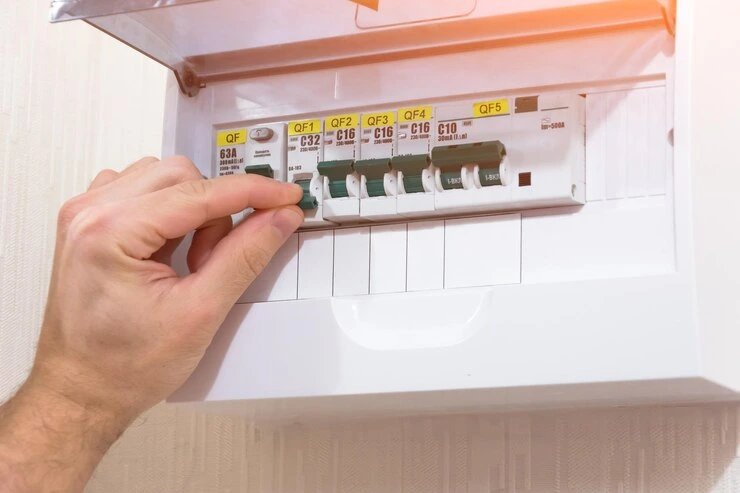Circuit breakers are safety devices that protect electrical circuits from overloads and short circuits. If a circuit breaker trips, the electrical current flowing through the circuit has exceeded the safe limit, and the breaker has automatically shut off the power to prevent damage or a fire. Here are the steps to reset a circuit breaker:
1. Locate the circuit breaker panel:
If so, you’re not alone. The circuit breaker panel is typically located near the main electrical panel and is often challenging to identify. Fortunately, you can take a few easy steps to find it.
First, look near the main electrical panel. This is usually the first place to look. The circuit breaker panel is often located close to the main electrical panel, so it’s worth a quick search. If you’re still having trouble, try checking near windows or doors that lead into the home or building.
Second, look for the circuit breaker panel label. Most circuit breaker panels have a brand that identifies the panel as a circuit breaker panel. If you can’t find the title, look for the circuit breaker panel’s switch. This switch is typically located near the main electrical panel.
Third, if you’re still having trouble locating the circuit breaker panel, you can look for a diagram of the home or building’s electrical system. This diagram should show the location of the circuit breaker panel.
2. Identify the tripped breaker:
Circuit breakers are essential components of any electrical system. They are designed to protect wiring and equipment from overloads and short circuits. When Circuit Breakers trips, it will automatically reset itself when the power is restored.
However, sometimes the breaker may not reset itself, or it may trip too frequently. This can be very frustrating, especially if you need to know why the breaker is tripping. In this case, you must identify the tripped breaker and reset it manually.
The first step to identifying the tripped breaker is to look for the switch. A tripped breaker will have its switch in the middle position, or some cases; it will be in the off position or labeled as tripped. Once the tripped breakers are identified, the next step is to reset it.
To reset a circuit breaker, you will need to locate the breaker box. This is usually located in a basement, garage, or another area of the home. Once you have found the breaker box, open the cover and locate the tripped breaker. Once you have identified the tripped breaker, turn it off and then turn it back on.
3. Turn off all appliances and lights that are connected to the circuit:
When you experience a power outage, you must take the necessary steps to reset the circuit breaker. One of the most important steps is to turn off all the appliances and lights that are connected to the circuit. This is necessary to prevent an overload from occurring again.
When all the appliances and lights are turned off, it will reduce the amount of electricity running through the circuit. This will help to reduce the possibility of an overload, which could cause the circuit to trip again.
To turn off all the appliances and lights connected to the circuit, start by checking the breaker box. Look for the switch corresponding to the circuit that needs to be reset.
4. Reset the breaker:
Resetting a circuit breaker is one of the most common electrical problems homeowners encounter. And while it’s relatively simple to do, it’s still essential to get the job done right.
When a circuit breaker trips, the switch that controls it will move to the off position. To reset it, you’ll need to move the switch back to the on the part. This is where the services of an experienced electrician can be invaluable.
At Best Electrician in Oslo – Beste elektriker i Oslo, we’ve been helping homeowners reset their circuit breakers for years. Our team of certified electricians has extensive training and experience in all types of electrical work, including breakers resetting. We use advanced tools and techniques to diagnose and repair any electrical issues you may be having.
5. Turn on the appliances and lights:
Resetting a circuit breaker is an important safety measure that needs to be done to prevent any potential damage to your appliances and lights. Once it has been reset, it’s time to turn on the devices and lights connected to the circuit to ensure they are working correctly.
Before turning on any of the appliances, it’s important to ensure that the proper voltage is supplied to the circuit. Once you’ve ensured the voltage is correct, it’s time to turn on the appliances and lights. Depending on the type of appliance, you may need to press a power button, turn a key, or flip a switch.
6. Check the circuit:
When the power in your home suddenly goes out, it’s essential to check your circuit breaker first. If the circuit breaker has tripped, it’s time to take action. Before resetting the circuit breaker, it’s essential to determine the underlying cause. If the circuit breaker trips again, you should call an electrician to check the circuit.
They can identify the problem and provide you with a reliable solution. When you call an electrician, they typically start by inspecting the circuit breaker to determine the cause. This may include checking for loose wires, burnt-out fuses, or other problems.
Recapitulation
It’s important to remember that safety precautions should be taken when working with electrical components and equipment, and if you need help with how to do that, please consult a professional electrician. Our website is the go-to source for the latest updates and information.





More Stories
Decoding 5 Key Criteria for Picking the Best Plumbing Services
5 Signs It’s Time to Call a Plumber
Most Common Air Conditioner Repair Issues